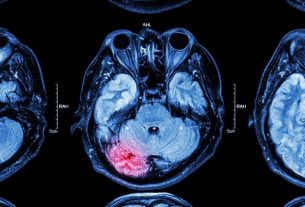A broken nose occurs when there is a break in the bones or cartilage, usually due to a blow to the face, such as falls, traffic accidents, physical attacks or contact sports.
The treatment aims to reduce pain, swelling and bleeding from the nose and is usually done with the use of analgesics or anti-inflammatories, such as Dipyrone or Ibuprofen, followed by surgery to realign the bones, if necessary.
Recovery usually takes around 7 days, but, in some cases, other surgeries may be necessary, until the nose is completely corrected.

Broken Nose Symptoms
The main symptoms of a broken nose are:
- Change in the shape of the nose;
- Pain and swelling in the nose;
- Purple spots on the nose or around the eyes;
- Nose bleeding;
- Very sensitive to touch;
- Difficulty breathing through the nose.
Children have a lower risk of a broken nose, because their bones and cartilage are more flexible, however, when it happens, it is most often caused by falls.
In babies, the bones of the nose can fracture at the time of birth and, in this case, it is identified by the deformity of the location, and surgery to correct it should take place as quickly as possible, to prevent the nose from becoming permanently crooked or causing breathing difficulties.
Make an appointment with the nearest orthopedist to assess the possibility of a broken nose:
Taking care of your health has never been easier!
What to do in case of suspicion
Oftentimes, a broken nose is simple and does not change the appearance of the nose. In these cases, and although it is always important to have an evaluation with a doctor, it is generally only recommended to take some precautions to reduce swelling and alleviate pain, such as:
- Apply a cold compress or ice in the nose, for about 10 minutes, to reduce pain and swelling;
- Do not move or try to put the bone in place, because this can worsen the injury;
- Taking painkillers or anti-inflammatory medicationssuch as Paracetamol or Ibuprofen, advised by a doctor.
If the nose is visibly deformed or if other symptoms appear, such as dark spots on the face or nose bleeding, it is important to go to the emergency room immediately to evaluate the fracture and begin the most appropriate treatment.
If you notice the presence of bleeding, you should remain sitting or with your head tilted forward and breathe through your mouth. If the bleeding is intense, gauze or cotton can be placed to plug the nostril, without pushing too much. Do not turn your head back, so that blood does not accumulate in your throat, and do not blow your nose, so as not to make the injury worse. Know what to do when your nose is bleeding.
When surgery is needed
Surgery is indicated whenever a displaced fracture of the nose bones occurs. After the initial treatment to reduce swelling, which can last between 1 and 7 days, surgery is performed to reposition the bones. The type of surgery and anesthesia will depend on each case and each patient. In case of serious fractures, surgery can be performed immediately.
After surgery, a special dressing is applied, which can be made of plaster or some rigid material, to help fix the bones and can remain in place for about 1 week.
Recovery from a broken nose is quick, usually around 7 days. However, sports with a risk of causing a new fracture should be avoided for 3 to 4 months, or as advised by your doctor.
Possible complications
Even after all the treatment, some complications may still arise due to a fractured nose, which must also be corrected by medication or surgery. The main ones are:
- Purple marks on the face, due to the accumulation of blood after bleeding;
- Reduction of the nose canal, which can make air passage difficult, due to irregular healing;
- Obstruction of the tear duct, which prevents the passage of tears, due to changes in healing;
- Infection, due to opening and manipulation of the nose during surgery.
Within 1 month, the nose fracture should be completely resolved, and the swelling should completely disappear. However, the person may still have a change in the shape and function of the nose when breathing and, therefore, may need to be evaluated by an ENT or plastic surgeon, as other surgeries may be necessary in the future.
Bibliography
- THE DUDLEY GROUP NHS. Suspected Broken Nose: emergency department. 2016. Disponível em: <http://www.dgft.nhs.uk/wp-content/uploads/2017/01/Suspected-broken-nose-UR.pdf>. Acesso em 05 jul 2019
- KING’S COLLEGE HOSPITAL NHS. Nose fractures: Information for patients. 2019. Available at: <https://www.kch.nhs.uk/Doc/pl%20-%20639.2%20-%20fractures%20of%20the%20nose.pdf>. Accessed on 05 Jul 2019

Sign up for our newsletter and stay up to date with exclusive news
that can transform your routine!
Warning: Undefined array key "title" in /home/storelat/public_html/wp-content/plugins/link-whisper-premium/templates/frontend/related-posts.php on line 12
Warning: Undefined array key "title_tag" in /home/storelat/public_html/wp-content/plugins/link-whisper-premium/templates/frontend/related-posts.php on line 13



